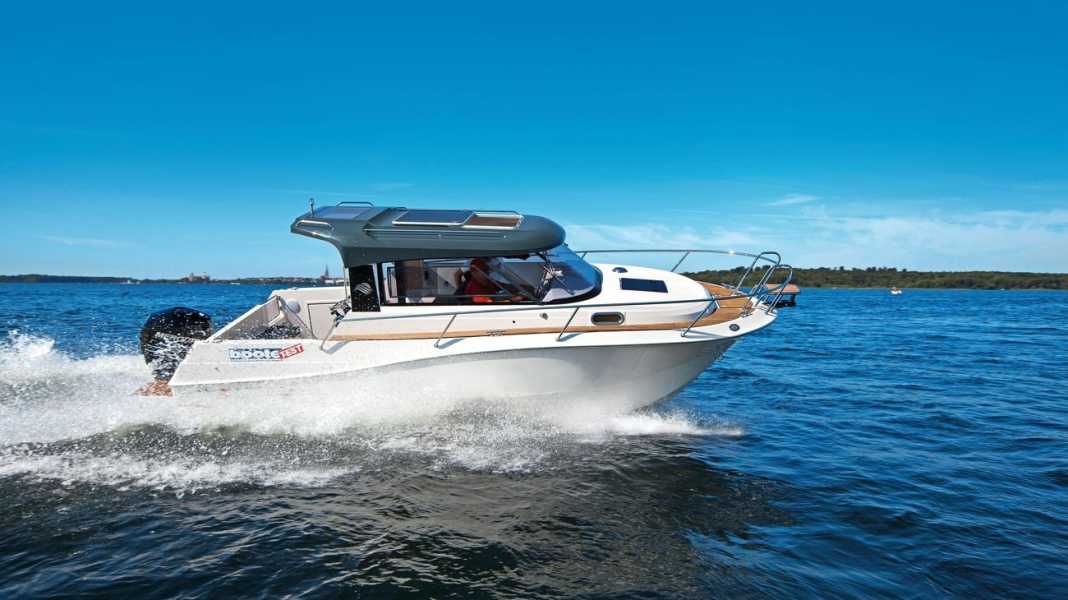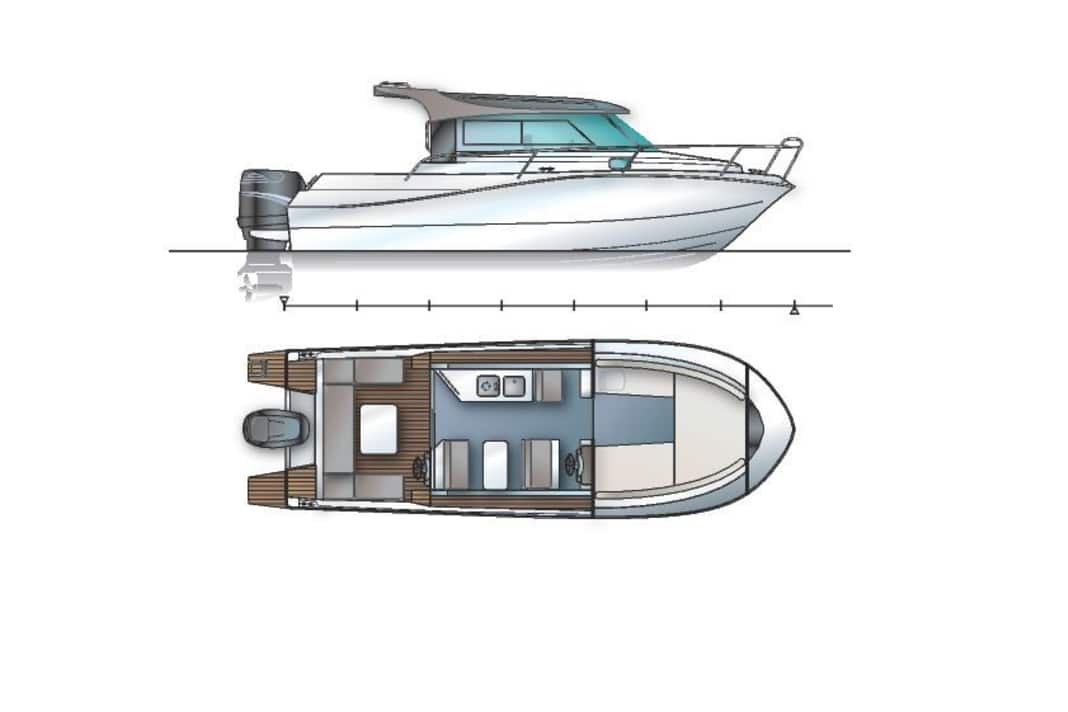






Boats with a driver's cabin have the advantage that you are well protected under the roof in bad weather. The dinette is then also dry, as on our Adventure 780 test boat; with an auxiliary heater, you can make the "den" cosy and warm and extend the travel time even further.
This also pleases the angler, as some fish are said to bite particularly well in autumn/winter. Extra tubes have been fitted under the side decks so that fishing enthusiasts can stow their equipment neatly. Two rod holders and a filleting table keep things tidy on board during the fishing trip.
And the best thing is that our test boat can also be steered from the cockpit at an extra driving position (extra charge) - so the skipper always has a direct line to his mates.
The boat is steered standing up on this additional console. The view to the front (through the rear window and the windscreen, which is about two metres away) is quite acceptable, but when the sun shines directly on it, there are annoying reflections - except for a strip about 20 cm high in the middle of the windscreen. If you prefer a direct view to the front, lean to the side and simply look past the cab.
The skipper sits on a wide bench in the cab. The unit can be adjusted lengthways, which provides sufficient knee room, and also serves as a dinette bench thanks to the folding backrest. The steering wheel and single-lever control can be operated without restriction; however, the cab is too low to steer while standing.
The instruments (engine: standard, navigation: accessory) are easy to read and the rocker switches with symbols are easy to operate. This also includes a switch for the windscreen wiper on the driver's side (passenger side for an extra charge), which clears the hardened plastic windscreen of splash water and raindrops. The shipyard has also recognised that the material is not yet optimal and will equip future boats with safety glass. Another change: the co-driver's seat is no longer installed so close to the side wall so that there is more arm room on the left.
Driving and manoeuvring
The Atlantic 780 is motorised with extra-long-shaft outboards up to 300 hp. We travelled with a Mercury Verado 250, whose steering and gearstick are controlled electronically. If you push the throttle slowly forwards, the bow rises from around 2200 rpm and lowers again when you reach planing speed (3500 rpm). Visibility is sufficiently maintained. In any case, the motor has enough steam to easily pull a tube behind it, although the stern wave is not exactly flat for water skiing.
The motor-boat combination glides well at 4000 rpm, which is also the most economical speed range.
With a consumption of a good 1.50 l/sm, we calculate a range of 146 nm plus 15% reserve with the 260-litre tank. At full throttle, this value is reduced by around 50 nm. The noise level is also positive: even at full throttle, it is only 82 dB(A) with the entrance door closed. If you open the latter, it increases to 85 dB(A), which is exactly within the BOOTE guideline value. For the rough water test, we had to make do with recreational boat waves, which our test boat skipped without any problems without splashing water.
"Hold on tight!" is the motto for fast manoeuvres, because the Atlantic makes very tight turns with noticeable centrifugal forces before the propeller draws in air and ends the fast ride. This happens a little earlier with the outboard trimmed than without. On slalom courses, the hull always swings controllably from one side to the other, regardless of the engine trim. When the steering is jerked, it makes a strong lateral movement; if you overdo it here, you will notice that the propeller is gasping for air.
The steering is smooth and precise in all situations - a characteristic that is also positively noticeable during harbour manoeuvres such as turning. Here, the Atlantic reacts directly and the turning circles are small both forwards and backwards. Canal skippers must first allow the hull to level out on a straight course and then make corrections from time to time.
Technology, security and living
Minor maintenance and inspection work on the engine can be carried out from the split bathing platform. For larger inspections or repairs, the rig should be mounted on a trailer (approx. 3200 kg); this allows you to work on the engine in peace (and without fear of parts falling into the water). The lines from the engine to the on-board outlet run in a flexible pipe, and from the rear to the front they are safely contained in a protective pipe. In the rear storage compartment and under the driving position, everything is reasonably well organised and firmly stowed away.
The tank system stands out particularly positively as it has a stopcock and a filter cartridge with an electrical alarm that is triggered if there is too much water in the filter. Two well-dimensioned 100 Ah batteries provide the 12 V supply. The corresponding selector switch is easily accessible at the cab entrance. To access the plug-in fuses, however, you first have to remove ten screws from a cover plate on the driver's platform.
Non-slip floor structures, handrails and railings ensure safe movement. Although the two electric bilge pumps provide a certain level of comfort, they are worthless in the event of a power failure. A hand bilge pump, which also works without electricity, is a different matter - although we searched in vain for one on the test boat. A fire extinguisher, on the other hand, was conveniently located in the entrance area, but it is also on the accessories list (surcharge: 75 euros). The opening windows in the driver's cabin, on the other hand, are provided by the shipyard as standard.
You have a good all-round view throughout the "little house" and the dinette offers enough space for two adults. It can be converted into a berth, but its use is limited due to its length of 1.55 metres. The dimensions of the bow berth (suitable for two adults) are much more generous. There was a marine toilet on the port side of the bow cabin on the test boat, which costs almost 2000 euros extra. However, our pre-production model lacked discretion, as the standard "rolling bulkhead" had not yet been installed.
Conclusion
The Atlantic Adventure 780 offers a wide range of possible uses. However, if you don't want to do without a certain level of comfort, such as a toilet, heating or galley, you will have to order and pay extra. Our test boat is a pre-production model and not everything is quite right yet. However, the shipyard and importer intend to remedy this in many areas.
Data sheet: Atlantic Adventure 780
Shipyard: Atlantic
Type designation: Atlantic Adventure 780
CE category: B - Outside coastal waters
Material of hull and deck: Plastic
Length: 7,83 m
Width: 2,55 m
Displacement: 2,20 t
Price: 55.000,00 €

